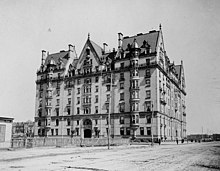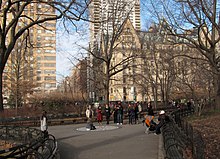The Dakota
| The Dakota | |
|---|---|

|
|
| Dakota Building, SO facade towards Central Park | |
| Basic data | |
| Place: | New York City |
| Opening: | 1884 |
| Renovation: | 2015 |
| Status : | Built |
| Architectural style : | Victorian architecture , neo-renaissance |
| Architect : | George Henry Griebel |
| Use / legal | |
| Usage : | Apartments |
| Apartments : | 103 |
| Client : | Edward Clark |
| Technical specifications | |
| Floors : | 10 |
| address | |
| Address: | 1 West 72nd Street |
| Post Code: | 10023 |
The Dakota (also called Dakota Building ) is an exclusive, traditional apartment block in New York City , on the corner of 72nd Street and Central Park West . The house was designed between 1880 and 1884 by George Henry Griebel , who worked for the Henry J. Hardenbergh architecture firm , in the French Renaissance style. Hardenbergh was also the architect of the famous New York Plaza Hotel , built in the same style . The Dakota was built by Edward Clark , the owner of the Singer sewing machine groupwho, however, did not live to see the completion. Since his son Alfred Corning Clark (1844-1896), a philanthropist , showed little interest in real estate, Edward Clark bequeathed the Dakota to his then 12-year-old grandson Edward Severin Clark (1870-1933).
The correct address for the Dakota is 1 West 72nd Street . Directly opposite the main entrance is the 72nd Street subway station. The inside of the building cannot be visited, the entrance is constantly guarded.
Meaning of the name
The name is said to have originated during the construction phase because the property was in the area of the then little developed Upper Manhattan , so that it was jokingly claimed that it was already in the tribal area of the Dakota . As a sign, the natural stone sculpture of an Indian head is embedded above the main entrance. The building plot was well chosen, however, as the building stands on a small elevation and at that time offered an unobstructed view of Manhattan Island, Long Island Sound and Brooklyn .
architecture
The nine-story building, including the top floors, is built around a rectangular, 27 × 17 meter (90 × 55 ft.) Atrium courtyard with two bronze fountains and occupies the entire block between 72nd and 73rd Streets. The Dakota originally had 65 suites. The seventh and eighth floors were designed as apartments for the servants, the ninth floor had a roof garden and a play area for children. After the Second World War, however, these areas were also expanded as living space, so that the number of residential units today comprises 93 luxurious apartments.
The idea of uniting several luxury apartments in one building was new, because at that time elegant and wealthy families lived in a villa designed and built especially for them with a large plot of land. The apartment building was a form of living for poorer sections of the population. The previously only rented apartments have been marketed as condominiums since the early 1960s. Until then, the management of the building was considered unprofitable. The rooms are four meters high and some apartments are more than 300 square meters.
The architect used yellow bricks as building material, which are optically contrasted with gray-brown sandstone at the corners, window and door openings . The facade is richly structured with windows, arches, bay windows, balconies and architectural decorative elements. A lavishly decorated, wrought-iron balcony leads around the sixth floor. The steep roof has several gables and is also structured by dormers, tall chimneys and windows.
The building's infrastructure was exceptional for its time. Meals could be taken in a large dining room, which also served as a ballroom. But it was also possible to have meals delivered to the apartments from a central kitchen with dining lifts. Four of the Otis safety elevators, which were just invented at the time, brought tenants and visitors into the apartments. The power supply came from an independent generator. All apartments had multiple bathrooms and toilets with flushing water and were centrally heated. There was a tennis court, a croquet lawn and a stable for horses and carriages on the property .
The Dakota was added to the National Register of Historic Places in April 1972 . In December 1976 it was recognized as a National Historic Landmark .
Residents
At the time of planning, the Upper West Side was by no means a posh address in Manhattan. That only changed when other luxury apartment buildings were built there as a result of the Dakota, for example: Osborne Apartments on 57th Street not far from Carnegie Hall , The Century between Central Park West and 63rd Street or The Dorilton, 171 West 71st Street. In addition, in 1882 (when the building was only half finished) the name of the former "Eighth Avenue" was changed to "Central Park West" in order to give the Dakota a more elegant sounding address. Even before they were ready for occupancy, all the apartments had been rented, mostly to rich and wealthy business people and bankers. The first tenants included a .: Theodore E. Steinway , Gustav Schirmer and Calvin H. Allen, President of the Union Copper and Mining Compay and the Western New York and Pennsylvania Railroad.
The Dakota apartments have always been some of the most expensive apartments in New York. The residents, including many prominent artists, were and are accordingly exclusive:
- the actress Lauren Bacall , who had lived there since 1961 and died in her apartment on August 12, 2014
- the conductor, pianist and composer Leonard Bernstein
- the actor Peter Boyle
- the actor José Ferrer
- the singer Roberta Flack
- the writer Charles Henri Ford
- the actress Judy Garland
- the singer and actress Judy Holliday
- the actor Boris Karloff
- the former boxer Mills Lane
- the actor Robert Ryan
- the musician John Lennon , who bought the apartment of the actor Robert Ryan
- the artist Yoko Ono , John Lennon's widow, who still lives in the Dakota today
- the dancer Rudolf Nureyev
- the music producer and musicologist Maynard Solomon
- the musician Sting
On December 8, 1980, John Lennon was assassinated just outside the entrance to the Dakota. An area of Central Park opposite the Dakota was named " Strawberry Fields " based on a song by the ex-Beatle . His widow Yoko Ono donated the planting . A black and white mosaic with the inscription "Imagine" is embedded in a crossroads , reminiscent of John Lennon.
Film and literature
The exposed structure also plays a role in literature and film:
- The 1970 novel The Other Shore of Time (original title: Time and Again) by Jack Finney has the Dakota Building as the setting. The commercial artist Si Morley is hired by a secret government agency and travels to New York in 1882. The author's extraordinary idea is that this journey through time should not be made with a machine but with the power of thought. Si Morley is renting an empty suite in the Dakota. Its surroundings, including the view of Central Park, is manipulated so skillfully that he believes he is in the 19th century. With targeted hypnotic training and the fact that he lives completely in this time, he also physically overcomes the time barrier and becomes involved in a corruption affair and a murder in the past. After his return to the present, the government agency in Washington steps in and wants to change history through time manipulation. Like Alaska from the Russians in 1867 , they want to buy Cuba from the Spaniards. As a result, Cuba should not become a communist country in the alternative present, but a federal state of the USA.
- In the 1968 film Rosemaries Baby by Roman Polański , Rosemarie and her husband Guy and the Castavet couple, who want to give the devil access to this world, live in the Dakota Building. Several scenes in the film were shot on the Dakota. Recordings in the rooms were not permitted and were made in the studio.
- In the 2001 film Vanilla Sky by Cameron Crowe , the protagonist David Aames, the sole heir to a media company (played by Tom Cruise ), lives in a luxury apartment in Dakota. Only the exterior shots were taken on the Dakota.
- Special Agent Pendergast, the main character in several bestselling novels by the author duo Douglas Preston and Lincoln Child , also lives in an apartment at the Dakota.
- In the novel The Hard Way by Lee Child , the commander resides mercenaries in Dakota. His apartment is his home and headquarters at the same time. Parts of the action take place in this apartment. Reference is made to some specifics of the Dakota, in particular to Yoko Ono, the security staff and the massive construction of the building.
- Windsor Horne Lockwood III , nicknamed Win, from the Myron-Bolitar series by Harlan Coben is resident in Dakota. Myron Bolitar lives with him at times.
miscellaneous
John Lennon and Yoko Ono announced the founding of the micronation Nutopia at a press conference on April 1, 1973 . The name was a word coined from the Anglo-American "new" and utopia . The flag consisted of a white cloth handkerchief and the national anthem consisted of three seconds of silence (later published on Lennon's album Mind Games ). The "embassy" of the fantasy state Nutopia was in the couple's apartment in the Dakota Building. A gold-plated plaque on the kitchen door indicated this.
literature
- Stephen Birmingham: Life at the Dakota: New York's Most Unusual Address . Syracuse University Press, 1996, ISBN 0-8156-0338-X .
Web links
- The Dakota at 1 West 72nd Street (English)
- Floor plans and other documents to different apartments of the building (English)
- Current images Dakota Building
Individual evidence
- ^ A b Stephen Birmingham: Life at the Dakota - New York's Most Unusual Address. Random House , New York City 1979, ISBN 0-394-41079-3 .
- ↑ Broker website (English)
- ↑ Christopher Cameron: Board approved: Who lives at The Dakota? . On January 5, 2017 from therealdeal.com, accessed October 3, 2018.
- ^ Dakota Apartments on the National Register Information System. National Park Service , accessed August 19, 2019.
- ↑ Listing of National Historic Landmarks by State: New York. National Park Service , accessed August 19, 2019.
- ↑ Christian Schröder: Love, flickering in the light of a match . On August 13, 2014 at tagesspiegel.de , accessed on October 3, 2018.
- ↑ Bruce Elder: Roberta Flack . On January 29, 2009 from smh.com.au , accessed on October 3, 2018.
- ^ Alberto Manguel : Longing Utopia. Folio-Verlag, Vienna 2018, ISBN 978-3-85256-758-7 .
Coordinates: 40 ° 46 ′ 36 " N , 73 ° 58 ′ 34.3" W.




